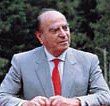As
a result, California is becoming another centre of car styling. In
contrast
to Turin, California is not bounded by tradition. Sunshine, Hollywood
and
multi-culture lead to freedom of thinking hardly matched by other
places,
thus gave birth to many radical designs, especially funny cars.
However,
no matter how commercially successful it is, so far we have yet to see
any cars coming from California as beautiful as Pininfarina’s Alfa GTV
and Peugeot 406 Coupe, or anything as stunning as Gandini ever did. In
fact, the most credible in-house studios recent years are also
non-California-based,
i.e., the Britain’s Jaguar studio (think of S-Type), the French Peugeot
(206 and 607) and Alfa Romeo studio (156 and 147), the latter is also
Turin-based.
The
world of car styling is now more diversified than ever.

His son Sergio is not a designer but a business genius who led the company to even more success. Design business spread to various Peugeot, Alfa, Lancia and Fiat while production facilities were upscaled to provide one-stop service of creating special edition cars for big car makers - from design, body building to final assembly. These Pininfarina-built and designed cars include Cadillac Allante, Peugeot 205CTi, 306 Cab, 406 Coupe, Fiat Coupe, Alfa old Spider and new GTV/Spider. Without the support of the plants, the company's design business would have been suffered as a result of the trend of in-house design.
Pininfarina’s designs are quite versatile - from supercar Ferrari to bread-and-butter Peugeot, from slippery Ferrari Dino to angular Alfa 164. Its designs are never too radical to be practical (unlike Bertone, Gandini and Gale). On the contrary, it is renowned for being able to inject sense of sexiness and elegance into an ordinary car with just minor tweaks of shape and details - look at the magic it did to Peugeot 205 GTI, 406 Coupe, 306 Cab and Alfa GTV and you’ll get what I mean. That’s why it is the studio I admire most.
Famous designs
Cisitalia 202, Alfa Romeo Duetto/Spider, Ferrari Testarossa:


Peugeot 205, Alfa Romeo 164, Ferrari 456GT, Ferrari F355:




Alfa Romeo GTV/Spider, Peugeot 406 Coupe, Ferrari 360 Modena / Spider:



More examples: Ferrari 275GTB, Dino, Daytona, 308GTB, 512BB, F40, Alfa 164, Fiat 124 Spider, Fiat Dino Spider, Lancia Beta Monte Carlo, Gamma Coupe, Peugeot 405, 605, 306 Cab and Cadillac Allante.

 One
of the big 3 studios in the world and, like Pininfarina, it has
assembly
plants. Founded by Giovanni Bertone in 1912 as a small coach-builder
and
then took over by his son Nuccio Bertone (1914-97) in 1930. Nuccio was
not a designer but he employed some greatest designers - Franco
Scaglione
(who penned Alfa Giulietta Sprint which drove Bertone to mass
production),
Giugiaro (Fiat 850 Spider), and then even more fruitful partnership
with
Marcello Gandini for 15 years, during which created Lamborghini Miura
(66),
Espada (68), Urraco (71), Countach (72), Alfa Montreal (71), Maserati
Khamsin
(72), Fiat X1/9 (73), Ferrari 308GT4 (73) and Lancia Stratos (74). In
the
80s and 90s, Bertone concentrated on the production of X1/9 and the
design
of Citroen BX (84), XM (89) and Xantia (92), then the assembly of Opel
Astra cabriolet and Fiat Punto cabriolet.
One
of the big 3 studios in the world and, like Pininfarina, it has
assembly
plants. Founded by Giovanni Bertone in 1912 as a small coach-builder
and
then took over by his son Nuccio Bertone (1914-97) in 1930. Nuccio was
not a designer but he employed some greatest designers - Franco
Scaglione
(who penned Alfa Giulietta Sprint which drove Bertone to mass
production),
Giugiaro (Fiat 850 Spider), and then even more fruitful partnership
with
Marcello Gandini for 15 years, during which created Lamborghini Miura
(66),
Espada (68), Urraco (71), Countach (72), Alfa Montreal (71), Maserati
Khamsin
(72), Fiat X1/9 (73), Ferrari 308GT4 (73) and Lancia Stratos (74). In
the
80s and 90s, Bertone concentrated on the production of X1/9 and the
design
of Citroen BX (84), XM (89) and Xantia (92), then the assembly of Opel
Astra cabriolet and Fiat Punto cabriolet.
In the past 25 years, Bertone's designs emphasised angular and wedged shapes. This made them looking special and futuristic but also drove customers away, especially in the organic-fancy late 80s and 90s. Today only Citroen remains to be its long-term admirer. On the other hand, Opel still employed Bertone to build Astra Coupe.
Famous designs
Alfa Romeo Giulietta Sprint, Fiat 850 Spider, Lamborghini Miura:


Lamborghini Espada, Alfa Romeo Montreal, Lamborghini Urraco:



Lamborghini Countach, Maserati Khamsin, Fiat X1/9:



Lancia Stratos, Citroen XM, Citroen Xantia:



More examples: Ferrari 308GT4, Lamborghini Espada, CItroen BX, AX, ZX

Unlike Bertone, Giugiaro loves concordent designs. His cars, except the ultra-low Lotus Esprit, never sacrifice practicality. As a result, many manufacturers from the West to the East adopt his designs, including VW Golf MkI, Fiat Croma, Punto, Renault 21, Isuzu Piazza, Subaru SVX, Lexus GS300 and recently the whole line-up of Daewoo.
It is necessary to mention that Giugiaro pioneered "tall-body" design with Fiat Panda and Uno which have a great influence to modern car design since then. However, after the Uno, Giugiaro's designs lost most of the imagination that characterised his years in Bertone, Ghia and the early Italdesign years. Fiat Punto Mk1, Daweoo Matiz and Msaerati 3200GT are some of the rare attractive designs.
Unlike Pininfarina and Bertone, the 3rd largest studio in the world has not yet involve manufacturing.
Famous designs
DeTomaso Mangusta, Maserati Bora/Merak, Lotus Esprit, Volkswagen Golf:



BMW M1, DeLorean DMC12, Alfa Romeo Alfetta GTV, Fiat Uno:




Fiat Punto Mk1, Seat Toledo Mk2, Daewoo Matiz, Maserati 3200GT:




More examples: Alfa Romeo Alfasud, Vokswagen Scirocco MkI, Lancia Delta MkI, Thema, Fiat Panda, Uno, Punto MkI, Croma, Saab 9000, Subaru SVX, Seat Ibiza Mk1&2, Toledo Mk1, Toyota Aristo Mk1 (Lexus GS300), Renault 19, 21, Daewoo Lanos, Leganza, Daihatsu Move.
Famous designs
Maserati Ghibli, DeTomaso Pantera:

Famous designs
Aston Martin DB4 GT, Aston Martin Vantage Zagato, Alfa Romeo SZ/RZ:



Undoubtedly, his designs are very aggressive, imaginative and futuristic, very suitable to supercars but usually has to sacrifice practicality (such as lack of headroom, poor visiblity, difficult entry and poor aerodynamics). Nearly all his designs, bar Miura, were loyal to his love affair of angular and wedge profile, even until his very latest car, Qvale Mangusta. So far he has yet to prove his talent in designing mainstream production cars.
Famous designs
Lamborghini Miura, Lamborghini Espada, Alfa Romeo Montreal:


Lamborghini Countach, Lamborghini Urraco, Maserati Khamsin:



Fiat X1/9, Lancia Stratos, Lamborghini Diablo:



Cizeta Moroder V16T, Bugatti EB110, Qvale Mangusta:



More examples: Maserati Shamal, Quattroporte Mk2, DeTomaso Pantera 200, Citroen BX

After leaving Pininfarina in 1988, he briefly joined Fiat and then started his own little studio in Turin, primarily design houses and gardens. However, in 1998 a Ferrari-style concept sports car called Fioravanti F100 was shown, indicating his intention to return to the automotive world.
Among his designs, Fioravanti loves the Daytona most.
Famous designs
Ferrari Dino, 308GTB, Daytona, Berlinetta Boxer:




Among all his designs, Lyons preferred the XJ most.
Famous designs
Jaguar SS100, XK120, XJ6:



Famous designs
Jaguar XJ220, S-Type:


In 99 and 2000, he secured posts in Prodrive and Rover as design chief but still hardly called full-time posts.
Famous designs
Jaguar XJR-15, Lotus Elan M100, McLaren F1:



His designs - though far from being my favourite - emphasised long, wide, low, chrome details, wrap-around windshield and aircraft-inspired tail fins, all characterised the American cars in the "good old days". However, it also prove his ignorance to engineering principles, making American cars suffered from notorious handling and criticised by some artists as exaggerative and over-decorated. Even after retired, his principles of "long and wide" extended to the muscle cars era of the 60s and early 70s, hence putting American cars in deep trouble during oil crisis.

Famous designs
Dodge Viper, Dodge Intrepid, Plymouth Prowler, Chrysler PT Cruiser:



More examples: Dodge Neon Mk1&2, Dodge Intrepid Mk1, Dodge Ram Pickup.